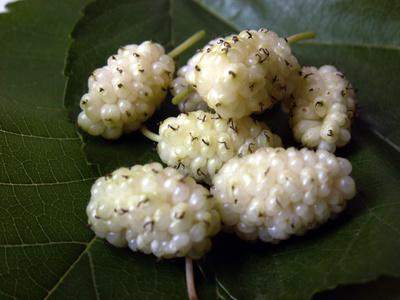White mulberry is also known by its scientific name, Morus alba. It is a species native to the northern parts of China. This plant is used to feed silkworms, and it is also known to be an invasive plant due to its rapid release of pollen. The stamens of the Morus alba act like catapults, launching the pollen at roughly 350 miles per hour, which is half the speed of sound. This has earned it recognition as the fastest known movement within the plant kingdom. White mulberry is also known as Tuta in Hindi, Tuti in Sanskrit and Toot, in Persian and Armenian.
US and Canada customer can order Organic Mulberry Leaf Tea here: Zi Chun Teas
The Curse of Morus Alba
Since it is used to feed silkworms, the cultivation of the white mulberry began over four thousand years ago in China. This species has also spread widely in India, Afghanistan, Iran and to parts of Southern Europe. In recent years, it has spread to areas in North America where it hybridizes with the local Morus rubra or red mulberry. This makes many worry about the long-term genetic viability of the Morus rubra. When viewed in that light, Morus alba seems to be a threat.
White Mulberry Benefits
Morus alba fruits have been used since ancient times. The Chinese used white mulberry to tonify the blood, for diabetes, constipation and to treat prematurely graying hair. The bark was used for wheezing, coughs and as a diuretic to promote urination. It has also been used for sore eyes, headaches and fever. Studies show that the root bark, which was used in Asian countries as an antibacterial treatment, can actually protect us from cariogenic bacteria. This antibacterial component is called kuwanon G.
Recent studies are focused on white mulberry leaf tea to combat diabetes. The ethanol extract from the Morus alba acts as an antihyperglycemic, shows antiglycation effects and works as an antioxidant as well. In a study based on 10 control subjects with type 2 diabetes in the age range of 24 to 61 years of age, it proved to be more effective than placebo medication.
White mulberry tea may also be best for people with elevated serum TG levels. A high level of this serum is considered a risk factor for arteriosclerosis.
Morus alba leaf extract is rich in 1-deoxynojirimycin, otherwise called DNJ, which inhibits a-glucosidase. A single group study was done wherein the subjects were made to ingest 12 mg of DNJ-rich mulberry extract three times daily after meals for 12 weeks. Studies showed a modest decrease of serum TG and an improvement in their lipid profile.
Therefore, while it may be considered potentially harmful for the viability of red mulberry trees, recent scientific discoveries show that the Morus alba may prove beneficial to humankind, as type 2 diabetes is a prevalent disease, owing to eating habits and other lifestyle factors. Is the white mulberry a cure that’s disguised as a curse? It may well be just that!
For US and Canadian customers Mulberry tea can be ordered from our Shopify online store
